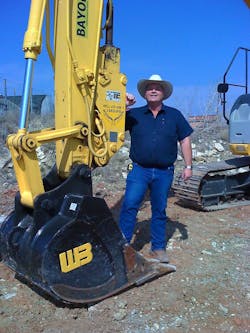It’s tough to be surprised by much these days, but when I encounter something that Construction Equipment editor Walt Moore hasn’t seen, I know it’s unique.
After a recent Buying File, I got an e-mail about an attachment called the Bayonet Breaker. The first thing I did was visit the link included so I could calm my suspicion that the Bayonet was merely more finely chiseled or extra stabby (okay, “stabby” is not a word, except on “The Simpsons”).
Turns out I was far from the, um, point.
The Bayonet is a hydraulic breaker that is plate-welded to the stick of a backhoe or excavator and drops down for operation—while the bucket remains on—allowing operators to use the breaker and the bucket interchangeably.
You can break rock and pick it up with one machine instead of two, or dig and then hammer without pause. There’s no need to get out of the cab to change anything.
See, the breaker tucks up under the stick, above the bucket, when it’s not in use. And the bucket remains fully open, up and away from the breaker, while you’re hammering. Simple genius. Saves money, saves time.
It’s a bit long by YouTube standards, but watch it work in this video.
(Bonus points if you recognized the hosts, Doug Llewelyn and Doug Llewelyn’s hair, from the original “People’s Court.” Not today’s tricked-up activist-judge version, but the real one with Judge Wapner himself!)
Video star power aside, I had questions for Texas-based Bayonet inventor and rental center founder Corky Underwood:
- How does the added weight affect the machine’s digging performance?
- Is there still enough room to heap the bucket to capacity?
- What does this do to an OEM’s warranty?
- Why isn’t this attachment absolutely everywhere?
- Is Doug’s hair real?
First, the Bayonet’s added weight is a positive for digging, according to Underwood, adding down pressure equal to the weight of the hammer. “If you take a shovel and try to dig into the ground holding it with just your hands, you’ll find you can do more if you put your foot on it.”
Fair enough. Now, about filling the bucket.
“It does affect it some,” Underwood says. But he quickly counters: “Putting a Bayonet on your backhoe is like putting nitrous on your Camaro and complaining about losing trunk space! You’ve got some baggage, but you can also use it as a thumb so you can trap stuff between there that you wouldn’t be able to with just the digging bucket.”
Underwood dismisses any warranty problems, as well. “Holt Caterpillar has sold more of them, really, than I have,” he says. “The real secret with Caterpillar is that Cat Financial will carry papers on them, and Cat Financial will not carry papers on any attachment that affects the warranty. That’s the ‘attaboy’ right there—it’s an approved Caterpillar aftermarket product.”
He adds that Case and Deere are also aware of installations and haven’t put out any bulletins about them. And the Bayonet isn’t everywhere simply because mass-producing conventional hammer manufacturers didn’t come up with it first, and it’s not the OEMs’ bailiwick.
“The hammer manufacturers got all those yachts and jets they have by doing what they do,” Underwood says, “and it’s not Cat’s core business. I had the means and the opportunity and the guts to do it.” Underwood also had a career path that afforded him the luxury of trial and error.
“It took a guy who stood in a ditch with a jackhammer when the air hose blew off and beat the crap out of him, who later became an equipment supplier,” he says. “He went from a user of these things to the supplier of these things. It was the perfect storm—the guy who had the passion about doing something finally got the tools and could make the mistakes—because they weren’t going to break me.
“A hammer is the most expensive thing on any machine; a hammer costs $10 to $12 a pound. So when I started messing with them, I’m taking a $50,000 to $60,000 piece of equipment and taking a cutting torch to it. That’s why nobody else came up with it and it took so long. From the tender age of 15, I continually tried to think about ways you could go from hammering to digging quickly without having to get off the machine.”
After covering Underwood’s journey from installing septic tanks and breaking rock in the 1970s to producing the first Bayonet prototype in the late 1990s, we finally get to the last burning issue—Doug Llewelyn’s hair.
This is the only time during the whole conversation that Underwood pauses for a beat. “Yes,” he says. “Yes it is. That’s real hair, but he doesn’t have much of it—he keeps it kind of laminated, you know?”
Underwood knows his hammers—and his lamination. I think Walt summed it up best when he said, “Corky’s a smart man.”
For more on Corky Underwood’s Bayonet (there’s something I never thought I’d write), go here. And, if you want to hire Doug and his ‘do for your video, click here.
About the Author
Frank Raczon
Raczon’s writing career spans nearly 25 years, including magazine publishing and public relations work with some of the industry’s major equipment manufacturers. He has won numerous awards in his career, including nods from the Construction Writers Association, the Association of Equipment Manufacturers, and BtoB magazine. He is responsible for the magazine's Buying Files.

